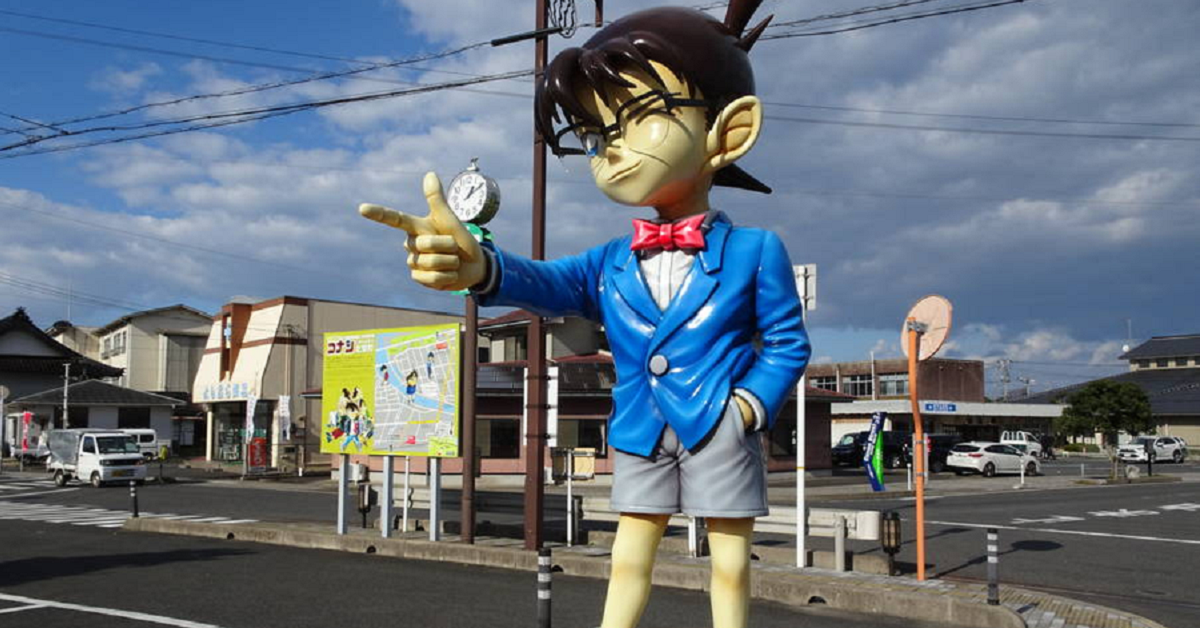Located in Hokuei Town, Tottori Prefecture, Conan Street is a beloved destination where visitors can walk through the world of Detective Conan. Stretching 1.4 kilometers from Conan Station to the Gosho Aoyama Manga Factory, the street features numerous bronze statues and monuments that bring iconic scenes to life, allowing fans to feel as if they’ve stepped right into the story.
What is Conan Street
Conan Street was created in Hokuei Town, the hometown of Gosho Aoyama, the creator of Detective Conan. Along the 1.4km route from JR Yura Station to the museum, visitors can experience scenes inspired by the series. The station, affectionately called “Conan Station,” features themed signs, ticket gates, and even platform decorations designed around the manga.
From the moment you arrive, you are drawn into the world of Conan. The station square features photo spots and a Conan-themed mailbox, making it an ideal starting point for your walk.
Follow the Story Through Bronze Statues
Lining the street are life-sized bronze statues of Conan, Ran, Kogoro, and the Detective Boys, each capturing memorable scenes from the manga and anime. Descriptive plaques explain the scenes, allowing even those unfamiliar with the series to appreciate the artistry and detail.
Among the most popular attractions are the skateboarding Conan statue and the bronze figure of Conan and Ran facing each other — both top photo spots shared widely on social media. At sunset, the statues glow warmly in the fading light, creating a magical, cinematic atmosphere that draws visitors to linger.
The Gosho Aoyama Manga Factory
At the end of the street lies the Gosho Aoyama Manga Factory, a museum dedicated to the creator’s life and work. Inside, you can explore original drawings, production notes, and interactive exhibits that reveal how the world-famous series came to life. Visitors can also enjoy mystery-solving activities, voice experiences, and exclusive merchandise available only here — a must-visit destination for true fans.
Highlights of the Museum
| Category | Details |
|---|---|
| Exhibitions | Original artwork, production notes, videos, and character profiles |
| Interactive areas | Mystery-solving games, photo booths, and voice recreations |
| Exclusive merchandise | Conan sweets, Hokuei T-shirts, stationery |
| Hours | 9:30 AM – 5:30 PM (last entry at 5:00 PM) |
| Closed | Year-end holidays (late December to early January) |
A Town Built Around Conan
The entire town of Hokuei has embraced the world of Detective Conan. From Conan-themed lamp posts and manhole covers to buildings inspired by the manga, the attention to detail creates an immersive atmosphere.
At the center of town lies “Conan’s House: Beika Shopping Street,” where visitors can enjoy cafés inspired by Café Poirot from the series, souvenir shops, and bakeries serving Conan-themed sweets.
Town Design Highlights
| Spot | Description |
|---|---|
| Conan Mailbox | A bright red mailbox engraved with Conan’s smiling face; commemorative stamps are available nearby. |
| Conan Bridge | Bridge railings feature reliefs of characters — a top photo location. |
| Beika Shopping Street | A lively area filled with shops and themed restaurants. |
| Conan Streetlights | At night, soft lights reveal the silhouettes of characters. |
Access Information
| Category | Details |
|---|---|
| Location | Yurashuku, Hokuei Town, Tottori Prefecture |
| Nearest station | JR San’in Main Line — Yura Station (Conan Station) |
| Distance | About 1.4 km from Yura Station to the Gosho Aoyama Manga Factory |
| Travel time | Around 20 minutes on foot |
| Parking | Free parking available at the museum |
| Recommended visit duration | 1 to 1.5 hours |
Recommended Walking Route
Begin your journey at Conan Station with a commemorative photo, then explore the exhibitions inside the station before starting your walk. Stroll down the street, stopping for photos and snacks, and finish your visit at the museum.
Suggested Model Course
| Step | Activity | Duration |
|---|---|---|
| Start | Photo session at Conan Station, explore station exhibits | 15 min |
| Walk | See the bronze statues, enjoy café break | 45 min |
| Finish | Visit the Gosho Aoyama Manga Factory | 60 min |
| Total | 1.5 to 2 hours for a full experience |
Seasonal Highlights
| Season | Description |
|---|---|
| Spring | Cherry blossoms bloom alongside bronze statues — a breathtaking sight that attracts many visitors. |
| Summer | Blue skies and greenery make the statues stand out; perfect for family trips. |
| Autumn | Fallen leaves and golden light give the street a warm, peaceful atmosphere. |
| Winter | Snow-covered statues create a serene, dreamlike landscape. |
A Community That Lives with Conan
Conan Street thrives thanks to the dedication and pride of local residents. Volunteers maintain the area, offer guided tours, and decorate the street seasonally. Every year, the “Conan Festival” enlivens the town with local food stalls, mystery games, and limited-edition merchandise.
Visitors often comment on the kindness and hospitality of Hokuei’s people, who treat Conan as a symbol of their town. This bond between the story and the community makes Conan Street more than a tourist attraction — it is a living piece of culture.
Conclusion
Conan Street in Hokuei Town is a place where creativity, community, and love for Detective Conan come together. Walking along the 1.4km route filled with bronze statues and monuments allows you to feel closer to the story’s heart. It reflects the hometown pride of Gosho Aoyama, the warmth of local residents, and the joy of countless visitors.
Every season reveals a new charm. As you stroll down the path, taking photos and reliving memories, you may feel as though you’ve stepped into the manga itself. When visiting Tottori, be sure to walk this “Path of Deduction and Discovery.”






